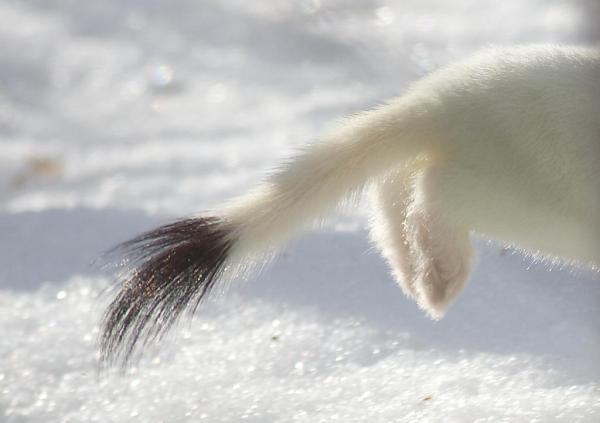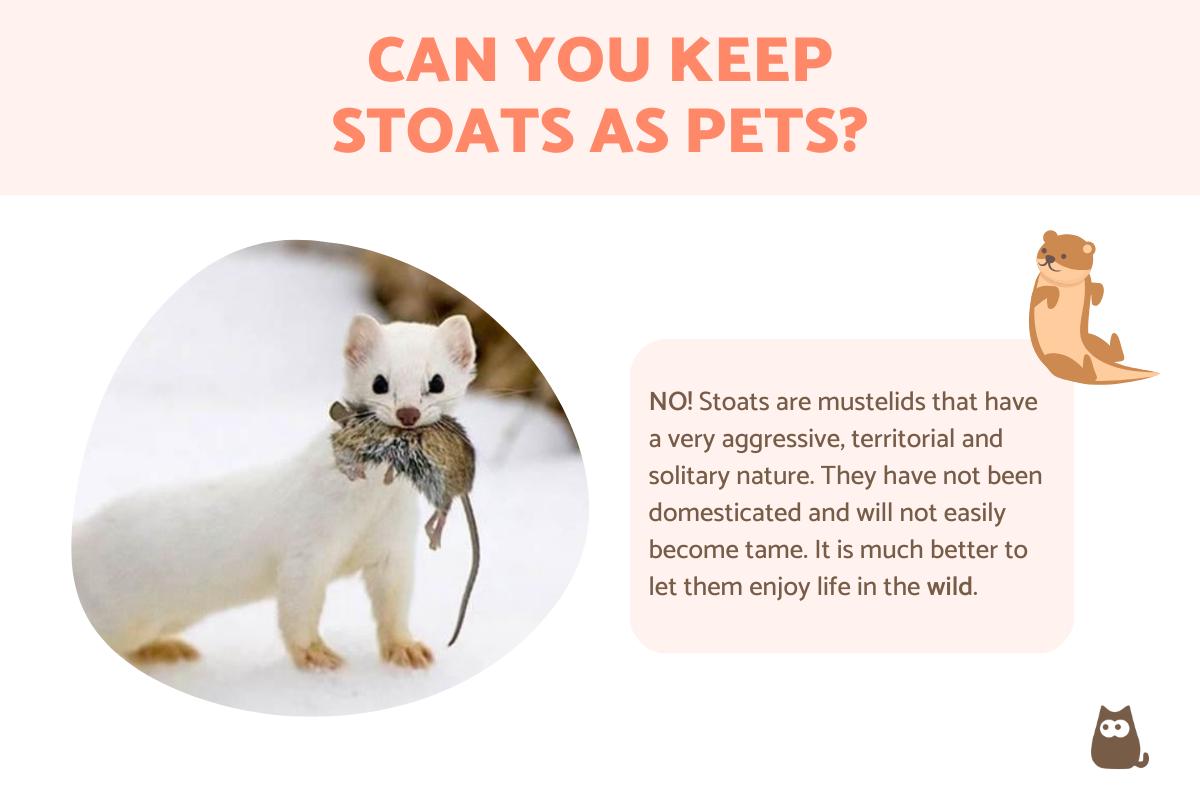Can You Have a Stoat as a Pet?


The stoat is part of the mustelid family, a group which also contains otters, badgers and ferrets, among other mammals. Larger than the weasel and considered particularly aggressive, stoats weigh less than 260 grams (9 oz). This gives them impressive agility and speed to add to their ferocity. In fact, stoats are capable of taking on and defeating prey twenty times heavier than themselves. Stoats are distributed around the northern areas of the Eurasian and North American continents, living in steppes and wooded alpine areas at low altitudes. They are not endangered animals, but they have been hunted and farmed for their fur.
Undoubtedly fascinating and cute, some have wondered can you have a stoat as a pet? With AnimalWised, we look in detail with our guide to pet stoats, providing guidelines and tips to help you know what to do.
Can you keep a stoats as pets?
The attraction to keeping stoats as pets is obvious when we look at them. Their cuteness and similarities to other companion animals makes us think they might be similarly suitable living companions. This is especially so when we see their close resemblance to ferrets, a domesticated member of the mustelid family. When we see stoats in action, we can have an idea of their behavior. It is this behavior makes them inappropriate pets.
Also known as ermines or short-tailed weasels, stoats are very active animals. They have a lot of energy and can move like lightening, running in and out of small spaces with great ease. Stoats are also very aggressive. This is to do with natural territoriality. For both males and females, the area they consider home will be protected at all costs. Even though we may let them into our homes, they will consider it their territory.
This aggressiveness will result in physical attack. Stoats have various levels of aggressive behavior, but they will bite when threatened. As wild animals which have not been domesticated, this will happen a lot. Although they feel soft to the touch, petting them isn't easy without having some significant bites.
Stoats are fierce carnivorous animals, specialized in biting the back of their prey's neck until they draw blood, regardless of whether it's a rabbit or an eagle. The stoat will cling to the back of the attacked animal, as the victim usually won't be able to reach them no matter if they have paws, claws or wings. Eventually, the wound will widen until the blood flow is unstoppable.
Since stoats can attack large animals twice their size, they can easily take down dogs and cats which are much larger than they. Since keeping stoats as pets is rare, records of them attacking humans are rare. However, attacks on young babies and seniors have been reported[1]. Cats have a greater chance of survival than dogs against stoat attacks. Mustelids can't climb, and cats can often reach the back of their necks with their claws - something that dogs don't find as easy.
The threat to other animals and even humans in the home can be serious, so you will need to keep it in consideration. Stoats will need plenty of space to run around for their own health, so if you cannot do this safely with other animals, it is not advised you keep them as pets. If you like the idea of keeping a pet stoat, check out our article on ferrets as pets. They meet very similar criteria, but are more domesticated and better suited to the home.
Stoats are not only inappropriate pets, they are considered one of the most aggressive animals in the world.
Is it legal to keep stoats as pets?
We strongly advise against adopting stoats as pets. Not only for the behavioral reasons we mention above, but there aren't any stoat breeding centers that we're aware of. It is not uncommon to confuse mink farms with stoat farms, but minks are a different mustelid species. When you do find stoats for sale, they are usually illegally captured wild specimens. If you buy one, you'll be promoting illegal and harmful wildlife trade.
It is not legal to keep stoats as pets in the USA. In fact, some states also ban ferrets and similar mustelid species. One reason is that these animals are considered a seriously invasive species. When irresponsible owners abandon them, they can have a seriously detrimental effect on the local ecosystem.
However, it's not uncommon to find orphaned stoats. This happens for various reasons, such as when the baby stoat gets lost or the mother dies. In these cases it is lawful to save the small kit and take it in for care. However, you will need to contact a wildlife recovery center. They will explain the immediate needs of the animal and how to meet them. They will also advise on whether they can take them in to eventually return them to the wild.
Before picking up a young stoat, you need to wait for them to call their mother. If she doesn't appear after a certain amount of time, you should take it upon yourself to save the life of the orphaned stoat.
Learn more about keeping pets and the law with our article asking is it illegal to leave a dog home alone overnight?

Caring for a baby stoat
When you discover an abandoned stoat, the main priority will be feeding the kit milk for stoats and ferrets to hydrate and satiate them. If the stoat kit already has some teeth, you'll have to supplement their diet with tiny pieces of meat, such as slices of turkey or chicken.
Even if you find a baby stoat and introduce them to humans from a young age, they are not likely to become good pets. While you may be able to accustom them to humans thanks to imprinting from a young age, they will never be domesticated since this is a process which takes many generations. Their aggressive, territorial and solitary nature means they will be difficult to look after and will not want to spend much time with you.
It is much better for the stoat to live in the wild. This is why wildlife recovery centers will be able to help reintroduce them, unless they are considered an invasive species in the area.
Learn about another mammal which makes a poor pet, although for different reasons, with our article on deer as pets.

What does a stoat look like?
There are more than 30 subspecies of stoat, but you can put them into two categories if we generalize:
- Cold climate stoats:have two types of colorings, as they molt their fur. During the winter, cold-climate stoats turn completely snow-white, except for the tip of their tail, which remains black. When they are white, stoats are more likely to be called ermines. During the summer, cold-climate stoats are a cinnamon color from head to tail, except for the black tip, and an ivory white on their underside.
- Temperate climate stoats: keep their summer coat all year round and they never turn white. As may be expected, their silky layer of fur becomes denser and warmer during the winter months.
A pet stoat's diet
Wild stoats are essentially carnivorous, although they will consume berries every once in a while. Stoats prey on insects, small and large birds, rabbits, hares, rats and mice and frogs. In fact, a stoat is very opportunistic and will attack almost any prey that crosses their path, as long as they have a chance at success.
As we have explained, keeping a stoat as a pet is extremely challenging at best. Giving them an appropriate diet at home will be difficult and managing their feeding requires expertise. This is why animal rehabilitation centers should care for stoats, since they have the resources and knowledge to meet the strict demands of the stoat.

Can a stoat live with other pets?
If you've had a pet stoat since they were very young it might be possible to get them to relate to a dog or a cat, but it is likely you will have problems. Stoats are solitary animals once they mature, so they will not want to play with your other companion animals and are likely to cause trouble. As we have explained, stoats will see almost any other animal as prey, resulting in possible attacks.
With other animals, you'll find it difficult to get a pet stoat to stop looking at your frightened parakeet or canary as prey. Their appetizing look will draw the preying stoat like a magnet. As we said, stoats can't climb, but they can jump very high and they are perfectly capable of catching birds. Their dexterity and tenacity means they could even open a birdcage or similar animal housing in the right circumstances.
If the stoat has been captured as an adult you will never manage to tame them. They will become a very dangerous guest for you, your family members and your pets. Don't adopt a stoat as a pet, but let them live in freedom. This is the same with other so-called exotic pets such raccoons and coatis.
Keeping stoats as pets is part of a larger trend of a desire to keep wild animals as pets. The problems with this impetus are explained in our video below:

If you want to read similar articles to Can You Have a Stoat as a Pet?, we recommend you visit our What you need to know category.
1. The Daily Mirror. (2006). Attacked by a Stoat.
https://www.mirror.co.uk/news/uk-news/attacked-by-a-stoat-703463







 We had a stoat 11 years in our kitchen, we adopt them when he was just 1-2 days old - 20gramms and blind for 10 days. At first: stoats can clim very very good! I think the best climbing-animal I saw in my life. And yes, it is difficulty to have a stoat as a pet. We never let it together with our cat, better for both. And yes, it is also not so nice for visitor which doesn´t like to get bite from a rappid fur flush : ) I could play with him very good ( the first year I played about an hour a day), I could touch him and he never bites me, but other people, they found it not so amuseing. And we tryed to teach him to do his business in a cat litter, we tryed, but often he did his business not in his place. But we had a very good time and we miss him.
We had a stoat 11 years in our kitchen, we adopt them when he was just 1-2 days old - 20gramms and blind for 10 days. At first: stoats can clim very very good! I think the best climbing-animal I saw in my life. And yes, it is difficulty to have a stoat as a pet. We never let it together with our cat, better for both. And yes, it is also not so nice for visitor which doesn´t like to get bite from a rappid fur flush : ) I could play with him very good ( the first year I played about an hour a day), I could touch him and he never bites me, but other people, they found it not so amuseing. And we tryed to teach him to do his business in a cat litter, we tryed, but often he did his business not in his place. But we had a very good time and we miss him.



